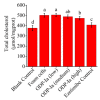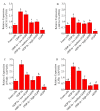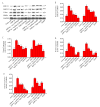Opuntia dillenii Haw. Polysaccharide Promotes Cholesterol Efflux in THP-1-Derived Foam Cells via the PPARγ-LXRα Signaling Pathway
- PMID: 36557773
- PMCID: PMC9781717
- DOI: 10.3390/molecules27248639
Opuntia dillenii Haw. Polysaccharide Promotes Cholesterol Efflux in THP-1-Derived Foam Cells via the PPARγ-LXRα Signaling Pathway
Abstract
There is increasing evidence supporting a role for enhanced macrophage cholesterol efflux in ameliorating atherosclerosis. Opuntia dillenii Haw. polysaccharide (ODP-Ia), the most important functional component obtained from Opuntia dillenii Haw. stem, has anti-atherosclerosis effects. Therefore, we propose that ODP-Ia could promote cholesterol efflux via the PPARγ-LXRα signaling pathway. In this study, THP-1 foam cells derived from macrophages were treated with different concentrations of ODP-Ia, GGPP (antagonist of LXRα) and GW9662 (antagonist of PPARγ), with or without 15 nmol ODP-Ia. The total cholesterol content in the cells was measured. The mRNA of ABCA1, ABCG1, PPARγ, LXRα and their protein levels in the foam cells were detected by RT−PCR and Western blot, respectively. The results showed that ODP-Ia plays a role in significantly promoting cholesterol efflux (p < 0.05) by upregulating the expression of ABCA1, ABCG1, SR-BI, PPARγ, PPARα and LXRα. Meanwhile, PPARγ and LXRα antagonists dramatically interfered the cholesterol efflux mediated by ODP-Ia (p < 0.05) and dramatically inhibited the upregulating effect of ODP-Ia on the expression of PPARγ, LXRα, ABCA1 and ABCG1 at both protein and mRNA levels (p < 0.05). In conclusion, ODP-Ia promotes cholesterol efflux in the foam cells through activating the PPARγ-LXRα signaling pathway. This bioactivity suggested that ODP-Ia may be of benefit in treating atherosclerosis.
Keywords: ABCA1; Opuntia dillenii Haw. polysaccharide; PPARγ-LXRα; THP-1-derived foam cells; cholesterol efflux.
Conflict of interest statement
The authors declare that the research was conducted in the absence of any commercial or financial relationships that could be construed as a potential conflict of interest.
Figures










Similar articles
-
Propofol up-regulates expression of ABCA1, ABCG1, and SR-B1 through the PPARγ/LXRα signaling pathway in THP-1 macrophage-derived foam cells.Cardiovasc Pathol. 2015 Jul-Aug;24(4):230-5. doi: 10.1016/j.carpath.2014.12.004. Epub 2014 Dec 27. Cardiovasc Pathol. 2015. PMID: 25600616
-
Leonurine Prevents Atherosclerosis Via Promoting the Expression of ABCA1 and ABCG1 in a Pparγ/Lxrα Signaling Pathway-Dependent Manner.Cell Physiol Biochem. 2017;43(4):1703-1717. doi: 10.1159/000484031. Epub 2017 Oct 18. Cell Physiol Biochem. 2017. PMID: 29045950
-
Lysophosphatidylcholine promotes cholesterol efflux from mouse macrophage foam cells via PPARgamma-LXRalpha-ABCA1-dependent pathway associated with apoE.Cell Biochem Funct. 2007 Jan-Feb;25(1):33-44. doi: 10.1002/cbf.1374. Cell Biochem Funct. 2007. PMID: 16981222
-
The Lian-Dou-Qing-Mai Formula activates the PPARγ-LXRα-ABCA1/ABCG1 pathway by regulating IL-10, leading to the promotion of cholesterol efflux and a reduction in atherosclerotic plaques.Histol Histopathol. 2025 Apr;40(4):585-596. doi: 10.14670/HH-18-803. Epub 2024 Aug 19. Histol Histopathol. 2025. PMID: 39315497
-
Extraction, purification, structural features and biological activities of the Opuntia dillenii polysaccharides: A review.Int J Biol Macromol. 2025 Jun;314:144253. doi: 10.1016/j.ijbiomac.2025.144253. Epub 2025 May 15. Int J Biol Macromol. 2025. PMID: 40381762 Review.
Cited by
-
Effect of Siegesbeckia glabrescens Extract on Foam Cell Formation in THP-1 Macrophages.Prev Nutr Food Sci. 2024 Sep 30;29(3):288-300. doi: 10.3746/pnf.2024.29.3.288. Prev Nutr Food Sci. 2024. PMID: 39371520 Free PMC article.
-
Therapeutic Potential of Bioactive Compounds from Traditional Chinese Medicine in Modulating Macrophage Cholesterol Metabolism for Atherosclerosis Treatment.Pharmaceuticals (Basel). 2025 Jul 25;18(8):1113. doi: 10.3390/ph18081113. Pharmaceuticals (Basel). 2025. PMID: 40872505 Free PMC article. Review.
References
MeSH terms
Substances
Grants and funding
LinkOut - more resources
Full Text Sources
Research Materials

